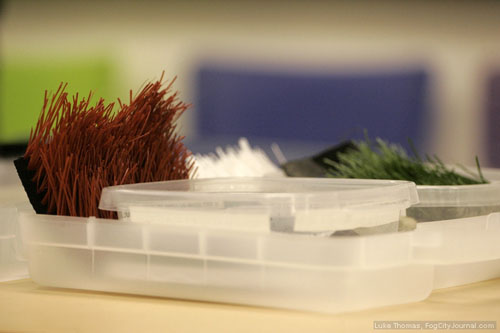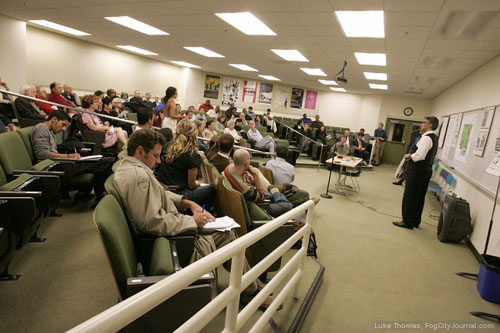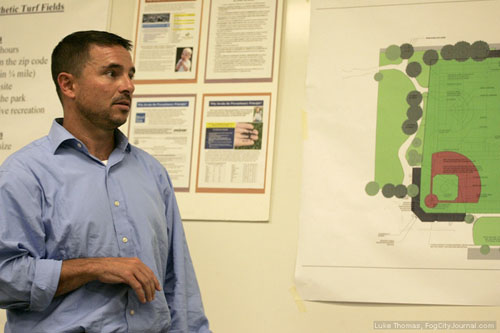
In a purported effort to lower park maintenance costs and increase field utilization,
the City of San Francisco, in partnership with the Fisher family,
has undertaken a program to replace natural turf surfaces with synthetics.
Photos by Luke Thomas
By Julian Davis, President of the Booker T. Washington Community Center
September 22, 2009
If you hadn’t noticed, the Rec and Park department is steadily replacing natural grass surfaces of our recreation grounds with synthetic astroturf. At least nine parks, including Franklin Square Park, Garfield Square Park and Silver Terrace Playground have already been astroturfed or are in the pipeline with funds committed for the conversion. At least 18 more parks are threatened with the same fate. That’s dozens upon dozens of acres of neighborhood parks that are filling up with hazardous waste every year.
The latest victim of this trend is the Western Addition’s Kimbell Park, where workers broke ground Wednesday September 16, two days after a contentious town hall meeting at the Jewish Community High School, hosted by Supervisor Ross Mirkarimi of District 5.

District 5 Supervisor Ross Mirkarimi addresses resident concerns
over astroturfing Kimbell Park during a community meeting
held at the Jewish Community High School.
Community members were split on the issue of astroturfing their neighborhood park. It’s a situation that is born out of frustration that the City has not been committed enough to maintaining the parks and fields in its care. Many residents rightfully want usable and maintained open spaces. Especially in light of current budgetary woes, astroturfing recreational fields has been presented as a cost-effective and maintenance-free method of preserving the functionality of parks.
On the other hand, there are serious questions about the health and environmental impacts of synthetic fields and the answers are often unsettling. That has left many people angry and upset that there has not been a greater effort to prevent potentially hazardous and toxic waste from being dumped in their parks.
One thing is certain, the City Fields Foundation, a private non-profit organization recently set-up by Bill, John and Bob Fisher, sons of Gap founder Donald Fisher, is crazy about synthetic turf. They just love it. In a purportedly philanthropic effort to address the city’s shortage of playfields, the Fishers’ Foundation has offered up millions of dollars to makeover San Francisco parks. There’s just one main condition, that Rec and Park install synthetic turf containing toxic plastic and rubber materials.
Why San Francisco is allowing a man who made his fortune on the backs of child sweatshop laborers on the other side of the globe dictate what is best for our kids’ recreation and health here at home is beyond me. City leaders should be investigating if the Fishers, or their associates, have any economic interests related to astroturf or synthetic field installation. Is there any good reason why a philanthropic effort to save the city’s parks not include the maintenance of natural grass?
Astroturf is made of plastic and ground up bits of tire rubber that contain carcinogens, hazardous chemicals, and heavy metals such as lead, zinc and arsenic. Results from a study published by The Connecticut Agricultural Experiment Station in 2007 indicated the presence of numerous chemicals detrimental to human health that are found in the tire-crumbs used in synthetic fields.
The Connecticut study investigated the composition of ground rubber and determined that the chemicals leached by mincing tires exceed the cancer risk threshold in young people, children, and babies. Although tire rubber is ‘recycled’ in astroturf, the process of replacing natural grass with synthetic astroturf is hardly carbon-neutral. Natural grass eliminates Co2, a major green house gas, from the atmosphere. Synthetic turf, on other hand, does not. It also contributes to significantly higher field temperatures and higher injury rates.
Growing concerns about the health and environmental risks of synthetic turf prompted State Attorney General Jerry Brown to file suit in September of last year against three manufacturers of artificial turf with the intention of compelling them to make public the dangerous levels of lead in their products. Around the same time, the California legislature passed Republican State Senator Abel Maldonado’s bill requiring the California Office of Environmental Health Hazard Assessment, in conjunction with the Department of Public Health and California Integrated Waste Management Board, to conduct a study investigating the health and environmental impacts of synthetic turf fields. The GOP State Senator had originally wanted to implement a moratorium on synthetic turf installations until the study was released, but these provisions were amended out of his bill before its passage. The study will be complete in September of 2010.
Despite these newly raised concerns and action to address the issue by state leaders of both major parties, prospective gubernatorial candidate Gavin Newsom’s San Francisco Rec and Park department is going full-steam-ahead to accept the Fisher family gifts of toxic astroturf. San Francisco’s own Synthetic Fields Task Force identified eleven environmental and health issues of public concern and could not determine if synthetic tire waste fields were safe, or if they pose harmful risk to children’s health. It confirmed that the finely ground up tire waste contains unregulated quantities of lead, carcinogens, and other hazardous chemicals, as well as reporting significant challenges to controlling the virulent bacterial growth in tire waste fields.
Newsom’s Rec and Park General Manager Phil Ginsburg attended the Kimbell Park town hall meeting touting the affordability and convenience of astroturf, despite the luke warm and inconclusive defense it received from the Department of the Environment staff who also made presentations to community attendees. Ginsburg insisted, after being questioned by youth athletes in the audience, that the synthetic fields require no maintenance and no water. However the City Fields Foundation’s own website states, “The Recreation and Park Department regularly cleans the fields of debris and grooms the turf to improve play.” This involves weekly sweeping, bi-monthly “broom drag” grooming, further bi-monthly grooming using a “field groomer,” and extra cleaning for which “park staff uses soap and water as recommended by the turf manufacturers.” In fact, without such grooming, synthetic fields develop bacteria that can easily lead to infection from common skin abrasions. In addition, synthetic fields have to be replaced every ten years at great expense, calling into question their affordability in the long-term.

Rec and Park General Manager Phil Ginsburg.
The bigger picture here is about the legacy we want to leave to current and future generations of San Francisco youth and residents. We are a city proud of our leadership on environmental issues and our rich heritage of natural beauty in an urban setting. Do we really want to leave plastic and rubber tire-waste fields where once we found natural grass and urban ecosystems?
Long-time Western Addition community activist Arnold Townsend is opposed to astroturf. “When kids go to park they ought to get dirty. You don’t find bugs on astroturf. Kids don’t learn about ecosystems on astroturf. No matter how much ball you play on it, it’s an unnatural setting,” he said.
What’s to be done?
1) Support Supervisor Mirkarimi’s resolution (091045), introduced August 18, requesting the Recreation and Park Department temporarily suspend the program of converting natural turf playing fields to artificial surfaces pending the release of a report by the California Office of Environmental Health Hazard Assessment on the health and environmental impacts of synthetic turf fields. This report is due next year and Mirkarimi’s resolution is a prime example of the intent of San Francisco’s policy of following the precautionary principle. The resolution was referred to the City Operations & Neighborhood Services Committee. Call or write committee members (Supervisors Bevan Dufty, Sean Elsbernd, and Chris Daly) encouraging them to approve the resolution.
2) Ask your Supervisors for an ordinance creating a moratorium on converting natural turf playing fields to artificial surfaces at least until the release of the state mandated report next year. Unfortunately the resolution before the board, though a highly persuasive statement of policy if it passes, can technically be ignored by the Rec and Park Department.
3) Ask the Government Audit & Oversight Committee of the Board of Supervisors to order an analysis of the long term cost comparison of synthetic turf vs. natural grass. Synthetic fields do require maintenance and costly full-scale replacement every ten years. What is the relative cost, over a thirty-year period, of natural grass vs. synthetic turf? You have a right to know before you end up with ground tire rubber in your neighborhood park. The members of this committee are Supervisors Ross Mirkarimi, Eric Mar, and Sophie Maxwell.


 The Hunger Site
The Hunger Site
May 8, 2012 at 4:28 pm
Public schools here in the province of Quebec, Canada, have gone wild over astroturf; I love this article, can anyone point me to other authoritative work on the downsides of astroturf. My son’s school has just decided to put in astroturf, and I need to marshall opposition against it urgently. In addition, if anybody has insight into the astroturf industry, I’d like all the information I can get — I suspect that manufacturers here are hand in glove with the local schoolboard officials, and perhaps the provincial government too. You can reach me — Tom Bergbusch — at tbergbus@dal.ca
September 24, 2009 at 7:46 am
As the City Fields Foundation / SF Rec & Parks removes the grass lawn at Kimbell Field
they are well aware that in regards to synthetic turf;
– the State of California Dept of Public Health is formally investigating it,
– the State of California Office of Environmental Health Hazard Assesment is investigating it,
– the United States EPA is reassesing it’s position concerning health risks,
– the California State Attorney General recently won a lawsuit against manufacturers for lead level violations,
– Oakland’s Center for Environmental Research has identified 5 known cancer causing agents in the tire crumb,
– New York City has enacted a moratorium because of health risks,
– at least 4 other states are conducting investigations,
– and the San Francisco Board of Supervisors have an outstanding resolution calling for a moratorium.
San Francisco already has 30 acres of synthetic fields.
Knowing all this, what could be the rationale for the City Fields Foundation/ and the SF Rec & Parks Dept to slip in another neighborhood tire dump?
September 23, 2009 at 11:08 am
regarding “What’s to be done?”–done!
thanks for an informative, action-oriented article.
September 22, 2009 at 8:04 pm
reminds me of the bright idea of the light brown apple moth spraying that thankfully never happened here. here’s a quote that can inspire in this latest assault on all that is good and natural, taken from Ross’ July 2008 newsletter:
“The massive outpouring of public opposition to the spraying, as well as legislation passed by the Board of Supervisors (authored by Supervisor Mirkarimi) and the State Senate, can be credited with stopping this potentially hazardous spraying. A collection of media stories can be found at playnotspray.org.”
and what’s wrong with teaching children (and others) about downtime needed for soil recovery? do we always have to have things at our fingertips, 24/7? that also brings to mind the slow food/fast food debate. Health comes to mind, pure and simple. I think our culture is crying out for a better relationship with nature all-round, not an eradication of it!
Surely there must be a way to preserve and maintain real grass in our parks! for real people!
September 22, 2009 at 7:01 pm
Yow!
If our better known national and world problems were not enough, we now have astroturf creep!
Who in their right mind could prefer astroturf to real grass??
The robots who self-serve at Safeway?
September 22, 2009 at 6:54 pm
We are going down the wrong path on this synthetic turf. The dangers outweigh the benefits and even the costs. We are pushing natural in other areas and why not in our parks which by the way have roots in nature.